
Contents
- Technology field service organizations face challenges with a retiring workforce
- Field service staffing challenges have been amplified by pandemic
- Field Service Outsourcing: Core vs. Context
- Field service outsourcing: An accepted approach for staff augmentation
- Reducing risk from the on-demand labor model
- An On-Site Talent Platform: More than crowdsourced field techs
- TSIA recommends: Embrace the on-demand model
Technology field service organizations face challenges with a retiring workforce
Field service technicians are a critical component of hardware service operations. Not only do they provide “break fix” service to keep customer equipment running effectively, but they are also increasingly providing “for fee” services for additional services revenue. And as they are face-to-face with customers in their home or office, they have a tremendous impact on overall customer experience, and how customers view the brand.
Many technology firms are faced with a looming shortage of field service technicians. In North America and EMEA, a significant portion of field service technicians are nearing retirement age.
- 46% of North American field techs are 50+.
- 50% of field techs in EMEA are 50+.
As these experienced techs leave the workforce, technology firms are struggling for strategies to replace them.
There are few available candidates with the same level of skills and experience, and the cost of hiring similar skill sets is cost-prohibitive.
Before being faced with a staffing crisis, companies need to look for creative approaches to deploying trained, skilled, and certified staff to meet the needs of customers, while providing an exceptional “branded” customer experience.
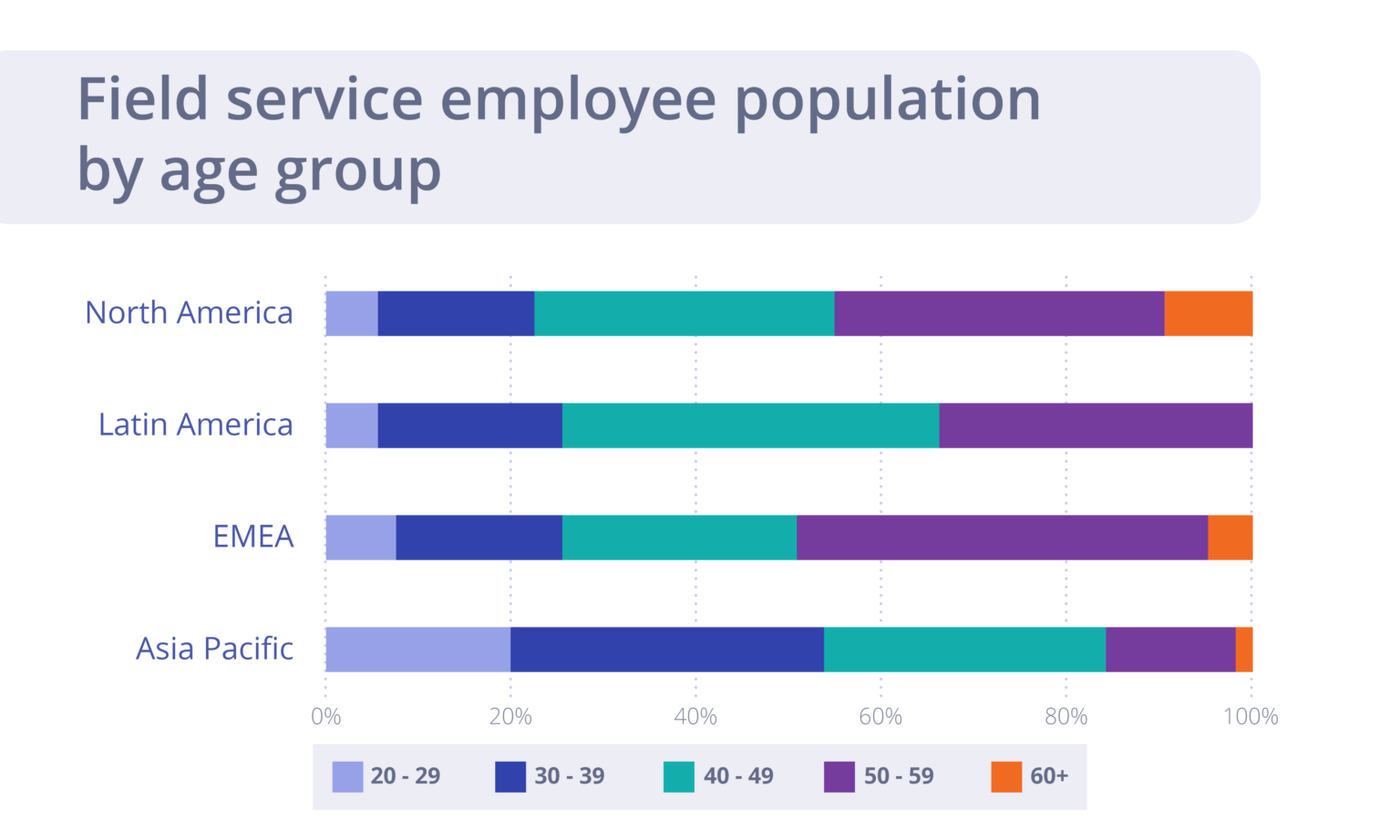
TSIA data
Field service staffing challenges have been amplified by pandemic
The retiring workforce is not the only challenge to field service staffing for technology companies. When the pandemic hit in early 2020, lockdowns and office shutdowns around the world, prevented in-person interactions, and impacted staffing.
In a TSIA Rapid Research Response (R3) Poll conducted in May of 2020, 24% of firms said they performed a reduction in their field service workforce in response. Another R3 Poll conducted in July 2020 showed that 67% of companies expected onsite incident volume to increase in the next 3 months.
As lockdowns end, and offices reopen, onsite incident volumes are increasing. Companies are contacting technology providers to request service for issues they have been ignoring for months due to shifting priorities, and the difficulty of scheduling onsite repairs during “shelter in place”.
But with a reduction of workforce accelerating the retiring of workers, the looming staffing crisis has arrived sooner than anticipated for many firms.
With the reasons cited previously, replacing staff is difficult and expensive, and companies are looking for a longer-term solution to ensure a reliable staffing model.
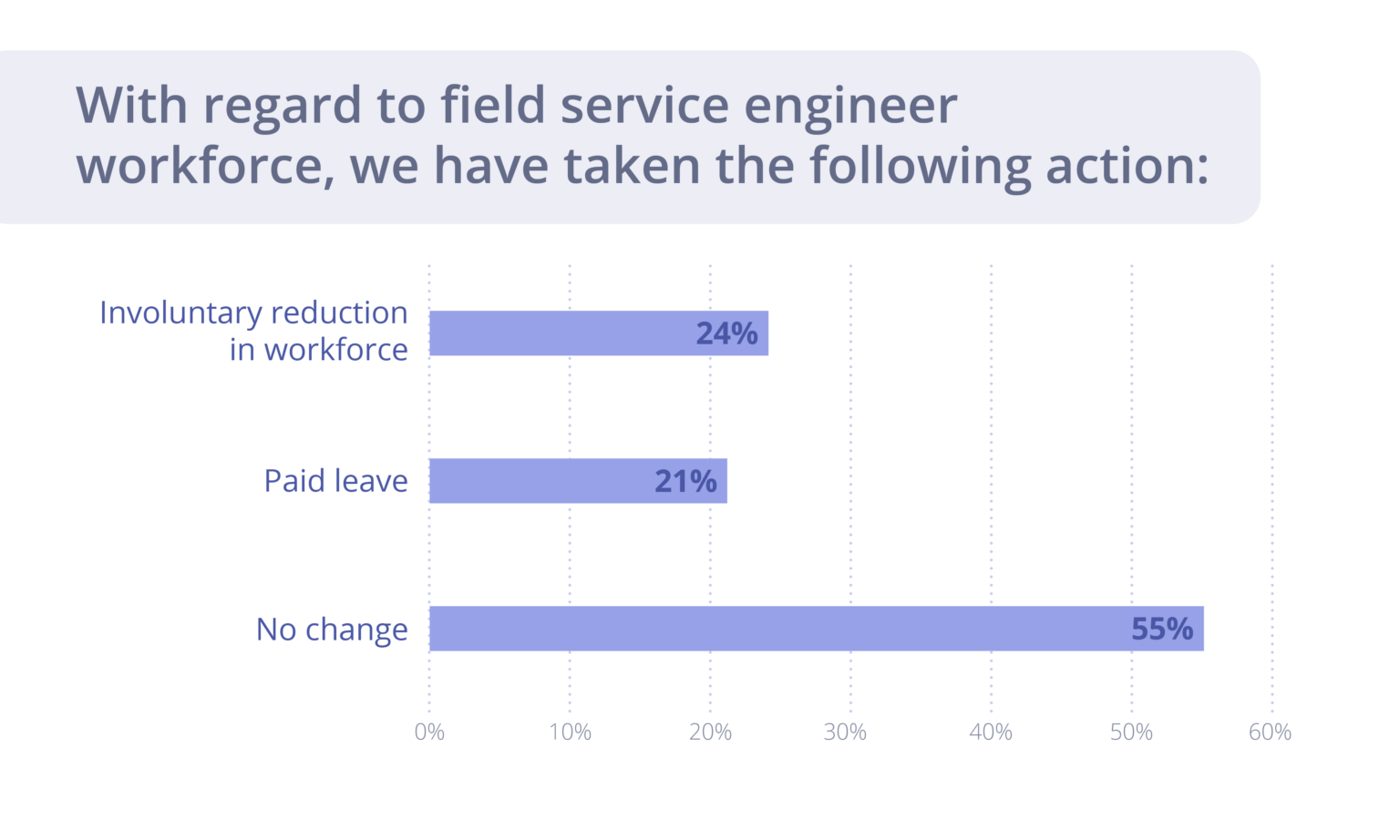
Source: TSIA R3 Poll, Field Services Impact, May 2020
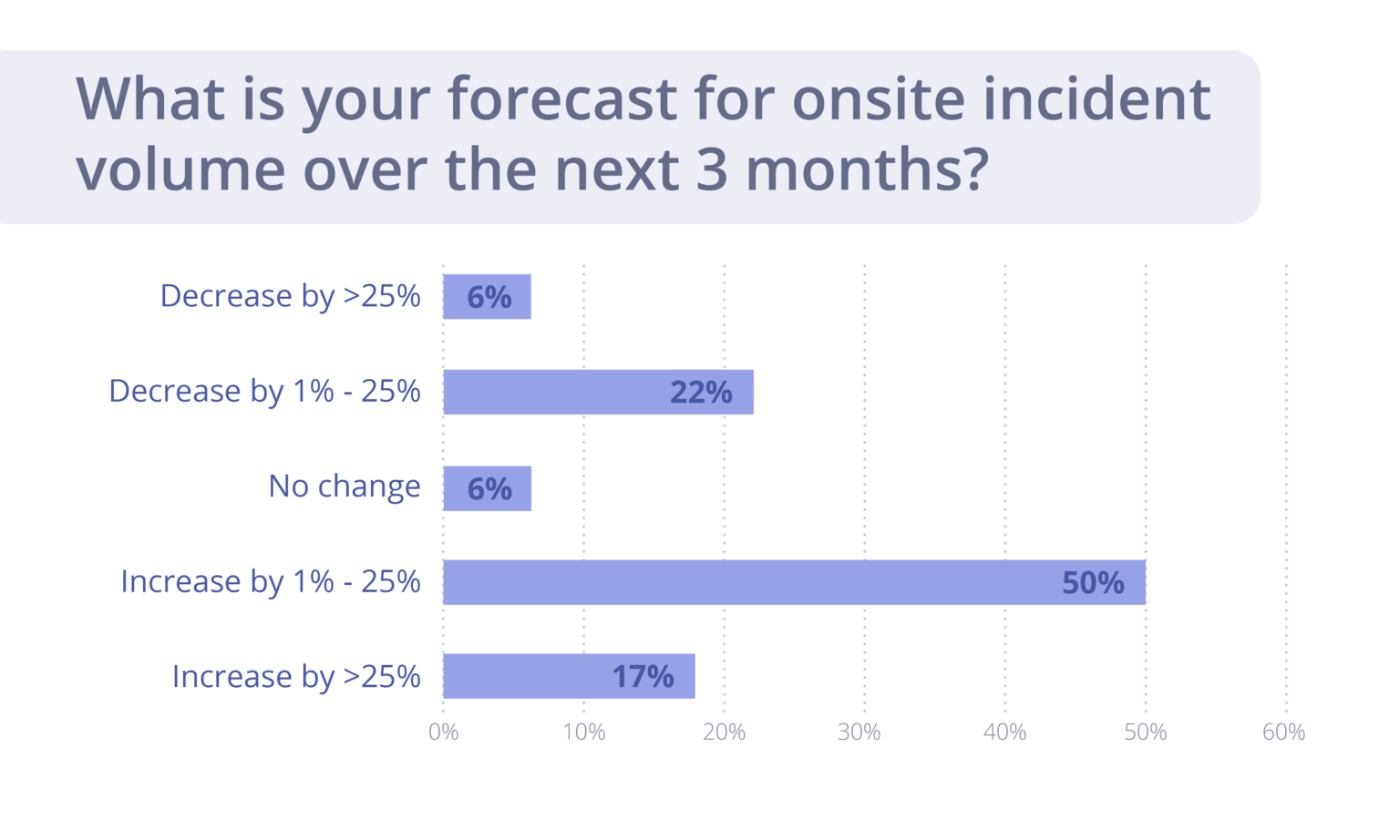
Source: TSIA R3 Poll, Field Service Incident Trends, July 2020
Field Service Outsourcing: Core vs. Context
An obvious approach to augmenting field service staff is to leverage outsourcing. Though tech companies may bristle at relying on a third party to fill these high-stakes positions, it is really a question of understanding core versus context.
- Core is something that delivers a competitive advantage to your company, and something you can do internally extremely well.
- Context is everything else, including operations that may be critical to success, but your abilities do not create differentiation or offer a competitive advantage.
For technology companies, “core” typically applies to your technology products, i.e., your intellectual property, which create unique and differentiating offers to the market.
As critical as support and field service is to the success of your company, and your customers, few technology firms go to market with service as their key competitive differentiator or value proposition
The challenge then is how to successfully partner with an outsourcing provider that can provide the skills required, in the locations you need, and still deliver an exceptional customer experience.
Field service outsourcing: An accepted approach for staff augmentation
Outsourcing field service is not a new concept. According to TSIA’s Field Service Benchmark, 89% of technology companies with field service operations leverage some level of outsourcing today, primarily for staff augmentation.
The most common reason staff augmentation is required is to increase geographic coverage. This allows you to provide onsite assistance for customers in geographies in which you do not have resident field techs, which ensures onsite availability without the costly option of flying a field tech to the location.
A total of 71% of companies who outsource field service say it allows them to quickly adjust to fluctuating workloads. As we have learned during the pandemic, being able to scale up and scale down our workforce to meet the sometimes dramatic fluctuations for onsite field service is now something every company needs to master.
Increasing service availability is another common reason for outsourcing, indicated by over two-thirds of companies. Staff augmentation allows you to meet your service level agreements (SLAs) for response and resolution time when existing staff is engaged in other appointments.
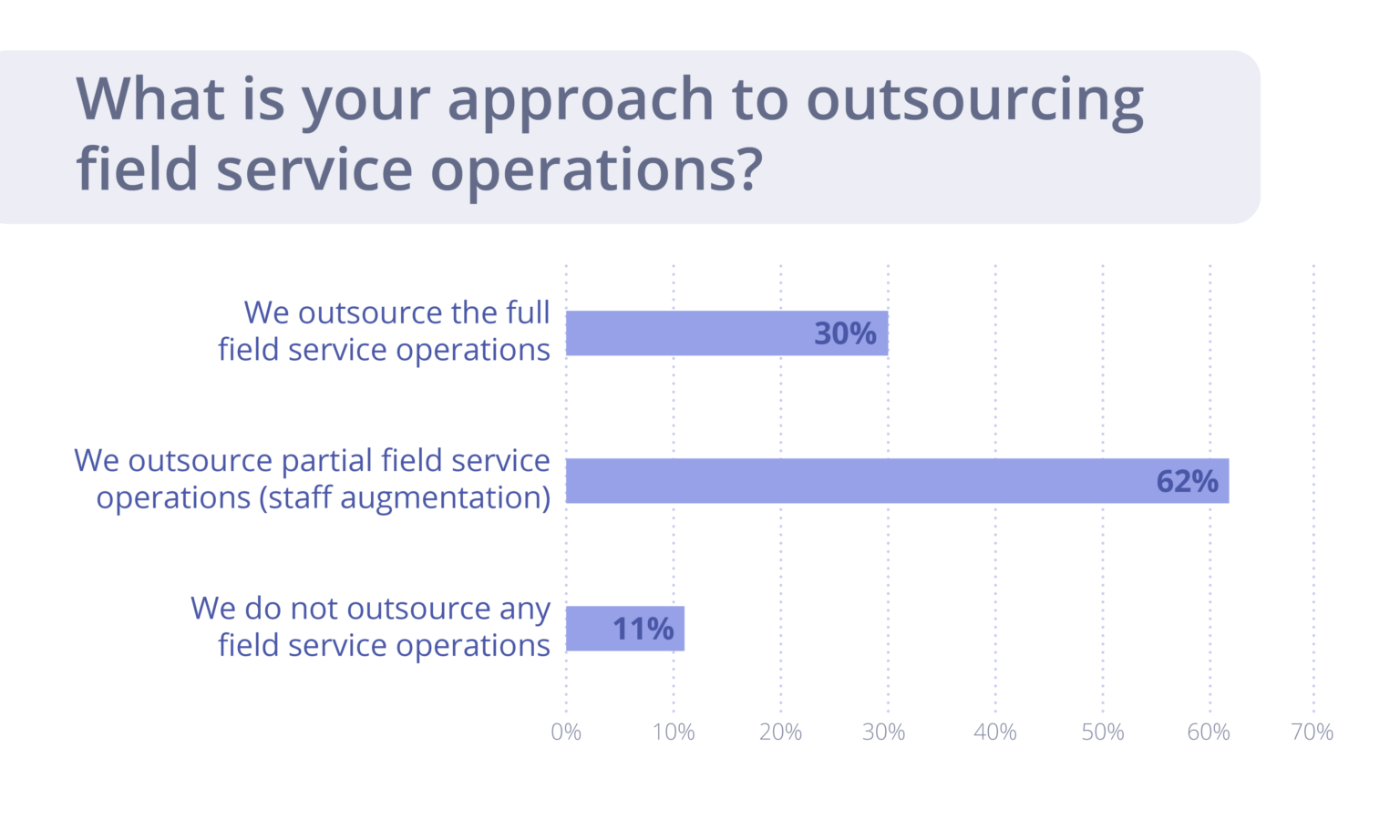
Source: TSIA 2021 Field Service Benchmark
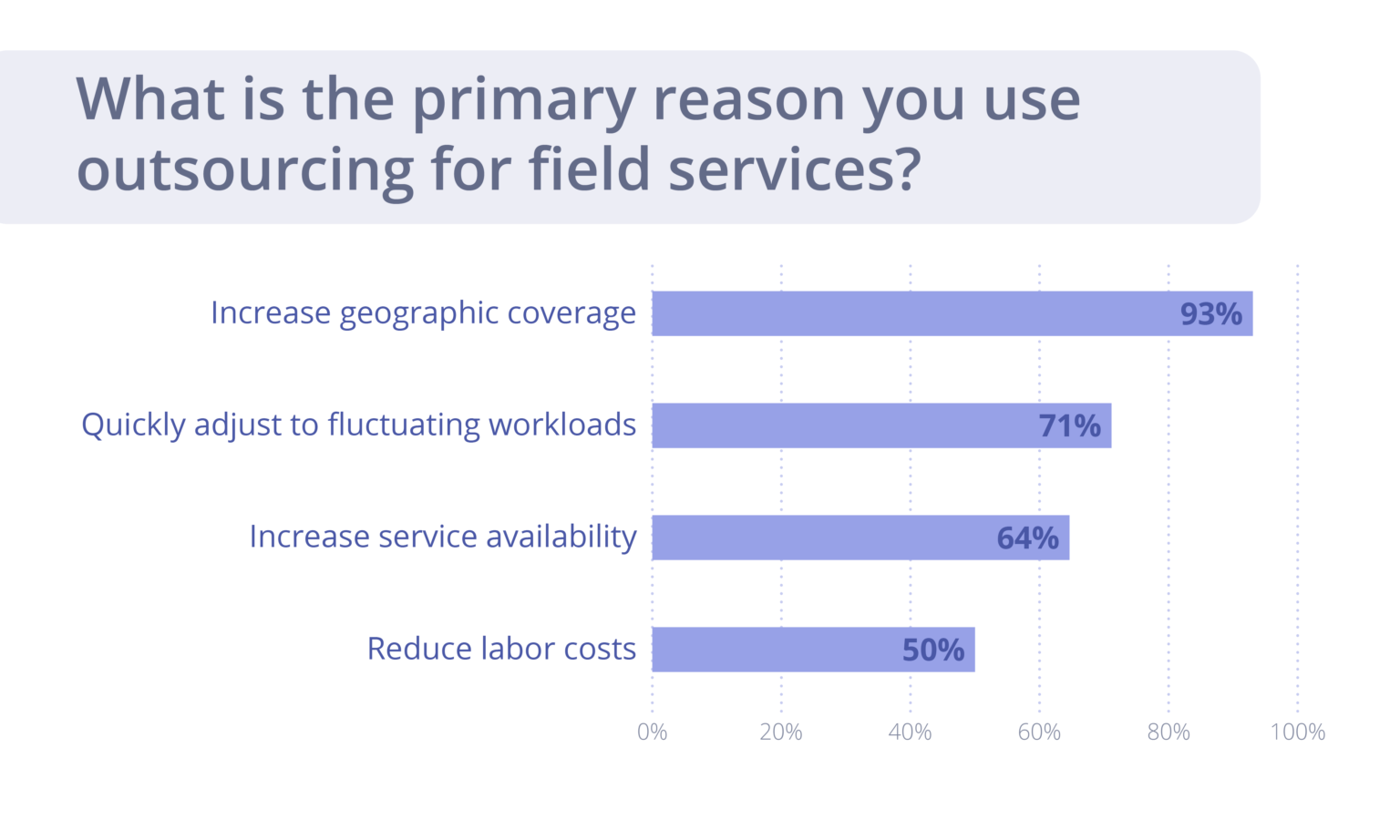
Source: TSIA 2021 Field Service Benchmark
Reducing risk from the on-demand labor model
The biggest trend in outsourcing and staff augmentation is looking to an on-demand model, or the “Uberization” of staffing. You define when and where you need staff, the skills required, and the price you want to pay, and interested third party resources can request or bid for the work.
While there is enormous potential in the on-demand or crowdsourcing model, companies are worried about the risks involved.
- How can they ensure the on-demand resource has the skills and experience they claim?
- Are they sure the on-demand resource has the necessary tools to perform the work?
- How do they know if the on-demand resource will provide the desired customer experience required to represent their brand?
Though companies had poor experiences with some early crowdsourced approaches with no oversight, today there are on-demand labor options available with strong oversight, and these have emerged as On-site Talent Platforms.
An On-Site Talent Platform: More than crowdsourced field techs
An on-site talent platform for finding qualified technicians can reduce these risks. Companies can define the exact skills, certifications, and experience required, and the platform provider screens candidates to learn more about their experience, as well as ensure customer service skills.
Once the profile for your requirements is defined, you have access to the on-site talent platform to:
- Post work orders. You define the scope, location, schedule, and pay, with templates and upload capability for high volumes.
- Access the marketplace of “best fit” technicians. Choose the best candidate for the job from the available pre-screened resources, with the ability to view each technician’s qualifications and reviews.
- Save your trusted technicians. Create pools of your favorite technicians based on skillset, location, type of work, or any other custom criteria. For future requests, you can route work to your previously vetted and approved technicians.
These platforms also automate paying technicians weekly and issue 1099 tax paperwork on your behalf at the end of the year.
Some providers of on-site talent platforms allow you to do more than identify and manage on-demand resources, you can also have access to their technology for scheduling and dispatch of your internal field service staff, as well as mobile capabilities.
According to TSIA’s Field Service Benchmark, and the Field Service Tech Stack Surveys, the average age of field service scheduling and dispatch tools is 6.5 years, with an average satisfaction score of 3.0 on a 5.0-point scale.
The average age of field service mobile tools is 4.2 years, with an average satisfaction score of 3.86 on a 5.0-point scale.
With technology evolving so quickly, particularly for mobile capabilities, looking to an on-demand talent platform to manage both owned and outsourced resources may allow you to dramatically increase the sophistication of your field service infrastructure, with instant access to the functionality without the complexity of a six-month internal implementation.
This approach gives you one set of consistent controls, reporting, and dashboards to oversee your entire operation.
TSIA recommends: Embrace the on-demand model
With field service organizations facing staffing shortages due to retiring workers, and the increasing challenge to hire highly skilled and affordable replacements, technology firms should not only consider outsourcing, but look to emerging providers of on-site talent platforms to fill their short and long-term staffing needs.
Technology firms should not only consider outsourcing, but look to emerging providers of on-site talent platforms to fill their short and long-term staffing needs.
- Think about core vs. context. You may be leveraging staff augmentation for a few remote locations today, but longer term, is maintaining an internal staff the best approach? Is your existing field service operation truly a competitive differentiator?
- While there are risks associated with a traditional crowdsourced approach to outsourcing, identify a provider that pre-screens resources to fit your exact profile to eliminate those risks.
- Consider a full on-site talent platform. With most field service infrastructure showing its age, the cost to acquire and implement a new platform from scratch may be a non-starter. However, some on-demand labor providers not only provide the talent, but the on-site talent platform you can leverage for both your internal and external resources, available via a technology subscription.
Hopefully, we will not be faced with another crisis in our lifetimes. But even without a pandemic, companies can experience dramatic fluctuations in demand for services due to economic issues, seasonal impacts, etc. And, with technology complexity rising every year, hiring and retaining field technicians will grow increasingly challenging. Transformation isn’t just about digital technology; it also means being open to new processes. Give the on-demand model a chance.



